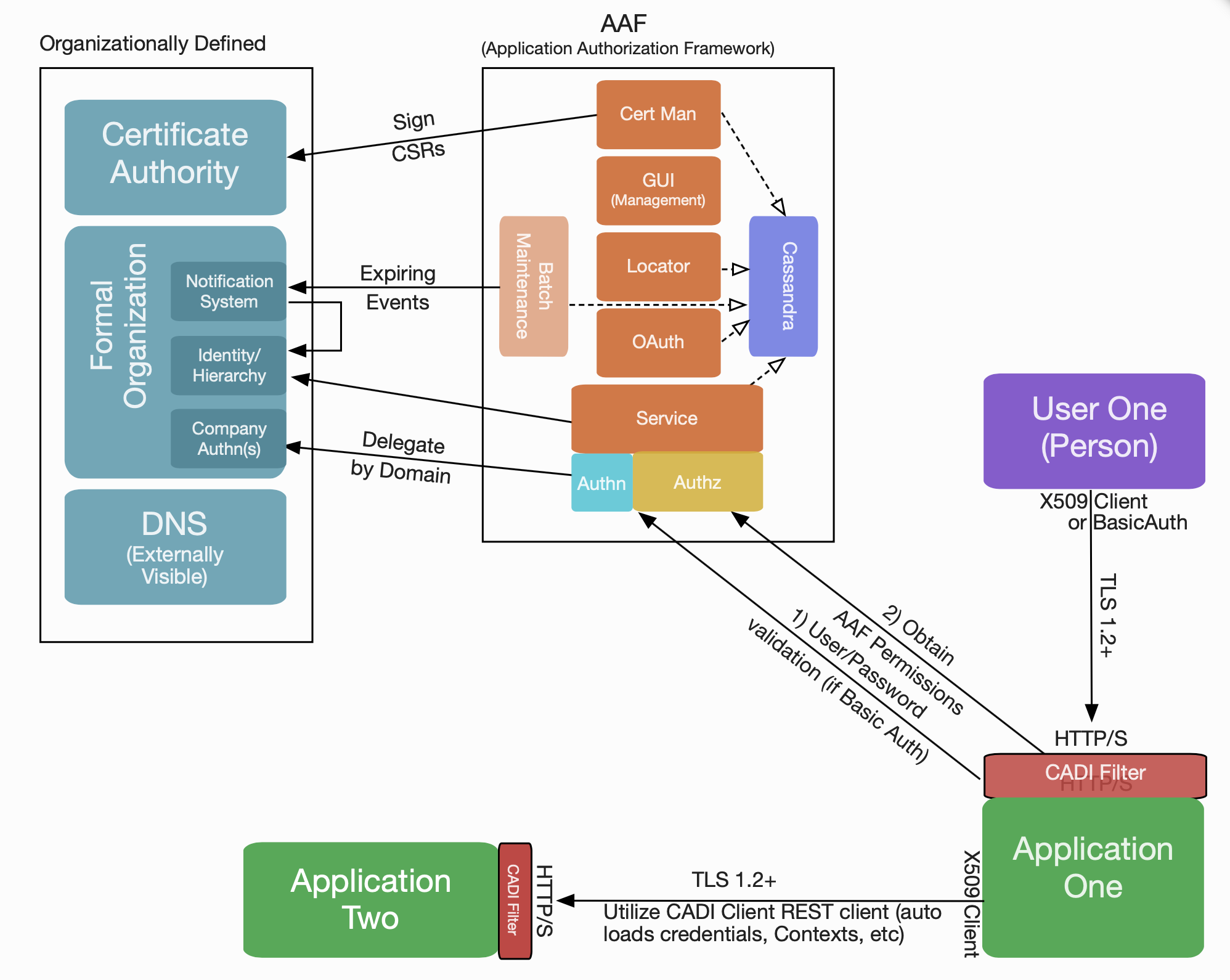PAGE STATUS: UNDER CONSTRUCTION
STATUS: Project Approved (next step is Architecture Approval)
AAF (Application Authorization Framework):
1 High Level Component Definition and Architectural Relationships
The AAF functional entity provides authentication, authorization and certificate management services for ONAP components. It provides the capability to:
- Allow each ONAP component to create a namespace to set up their authentication and authorization elements:
- Permissions
- Roles
- Credentials
- Access to organizational identities
- There is a default set of identities each ONAP component for use in ONAP Test Systems
- Store credentials for organizational identities
- Passwords
- AAF provides secure password storage for test/lab use only
- AAF has ability to delegate authentication to external authenticator
- Certificates
- These certificates have unique Authorized Identity embedded, which supports 2 way TLS Authentication
- These certificates can also be used as Server side certificates
- Passwords
- Manage fine grained permissions
- Provide ONAP components or other enforcement points with APP configured permissions
- Manage roles
- AAF provides roles for identities that include any granted permissions
- Validate and provide introspection of OAuth tokens
- Currently unused by ONAP
- Provide locator services through the AAF Locator
- AAF Components and ports can be found globally
- Locator facts
- Locator is not technically restricted to AAF. It can register (protected by Authentication/Authorization) any running process/port/interface
- Registrations include global coordinates, allowing clients to pick the "closest" one
- Locator is independent of any cluster or container mechanisms, which gives accessibility to any network accessible component
- Global - Components can reside anywhere in the world
- Scalable - A new instances can be started anywhere and instantly increase capacity and usage
- "For best results", use Cassandra scaling
- Resilient - VMs, clusters, data centers, K8S could go down, and AAF is still accessible.
- Provide a globally accessible file server to get public security information. For example,
- RCLs
- Root Certificates (any the Organization wants to publish)
- Organizational approved truststores
- Process approvals
- Authorize UI and API requests (REST interface)
- Authenticate users (human and application) (REST interface)
- Manage AAF components (REST interface)
- Auto-Generation of ONAP certificates
- For ONAP test/lab use, AAF Certman provides a local certificate authority (CA)
- AAF Certman can integrate with any certificate authority (CA) that supports the Simple Certificate Enrollment Protocol (SCEP). ONAP does not test this functionality
- Auto-configuration of ONAP certificates for ONAP clients
- as part of "Bare Metal"
- on Docker volumes
Additionally, AAF provides a Java client called CADI, which simplifies AAF use by an ONAP component. The CADI framework is a Java client that:
- Includes all AAF interactions: authentication, authorization, management
- Provides the following authentications: X509, BasicAuth and OAuth
- Provides adapter interfaces for external authenticators
- Includes a Shiro adapter to support ONAP use of ODL
2. API definitions
AAF provides real-time REST interfaces for
- Authorization
- Authentication, if local AAF authentication is used
- Management API for all AAF components, protected by strong authentication and authorization
CLAMP provides the following REST interfaces: TO BE UPDATED
| Interface Name | Interface Definition | Interface Capabilities |
|---|---|---|
| CLAMPE-1 | Control Loop Lifecycle Management Interface. | A user interface for:
|
| CLAMPE-2 | Control loop dashboard. User interface to show the overall status of the control loop through DMAAP events | Display and update:
|
Note: xxxI interface is a Component internal interface. xxxxE interface is a component external interface
The current API documents can be found at:
The provided UI interfaces are found at: CLAMP latest user guide
- CLAMP internal APIs can be found: clamp swagger pdf
AAF Consumes no Interfaces:
| Interface Name | Purpose Reason For Use |
|---|---|
3. Component Description: (IN PROGRESS)
A more detailed figure and description of the component.
<< For later inclusion >>
4. known system limitations: (IN PROGRESS)
Runtime: None
Clamp data redundancy is dependent on Kubernetes and the persistent volume.
Clamp application redundancy HA relies on Kubernetes
5. Used Models: (N/A)
6. System Deployment Architecture: (IN PROGRESS)
AAF consists of x containers:
- CLAMP container
- MariaDB container
- Kibana container
- E_Search container
- LogStash container
7. New Capabilities in this Release
This release, AAF adds the following capabilities:
AAF Locator differentiates public fully qualified domain name (FQDN) from Kubernetes FQDN
- Internal Kubernetes FQDN generated when client declares its container namespace
- Public FQDN are accessible for both:
- GUIs/Management outside cluster
- Non-ONAP entities outside the cluster
- Other clusters
- Improved documentation and enhanced configuration
- Example "Helm" init containers to setup volumes
- Refactored maintenance processes, including
- Analysis of expiring credentials and Roles
- Generation of approval records
- Notification of approvals, credentials and roles to support configurable integration with external services.
8. References
- AAF Overview & User Guide: https://onap.readthedocs.io/en/latest/submodules/aaf/authz.git/docs/index.html
- AAF internal interfaces: https://onap.readthedocs.io/en/latest/_downloads/d3c9f924c6586fe411d40a05ad9b1bb7/swagger.pdf
